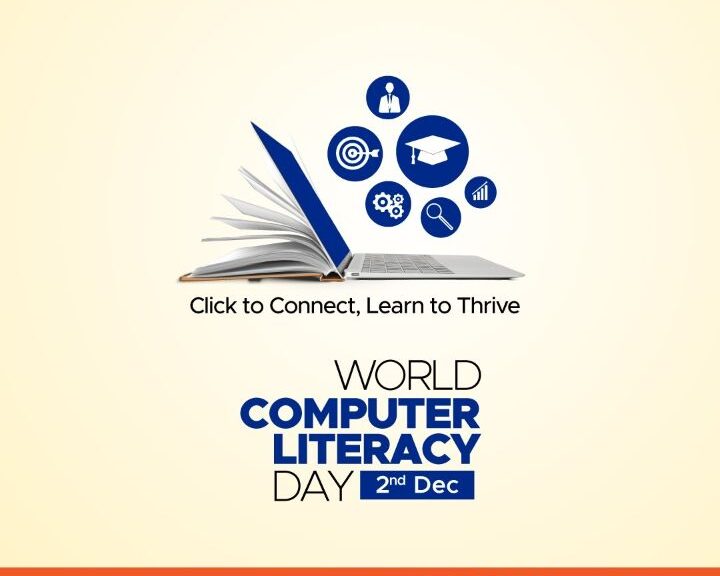💻 Introduction: The Digital Divide Is Real
Imagine living in a world where everything—communication, banking, healthcare, education—is done through screens and systems, but you don’t know how to operate a computer. For many, this isn’t fiction—it’s a harsh reality.
- 💻 Introduction: The Digital Divide Is Real
- 🕰️ History of World Computer Literacy Day
- 📅 Timeline of Key Milestones
- 💡 7 Powerful Facts About Computer Literacy Everyone Should Know
- ❓ Frequently Asked Questions (FAQs)
- ❓ What is World Computer Literacy Day?
- ❓ Who started it and why?
- ❓ Why is it important?
- ❓ How is it celebrated?
- ❓ Who benefits the most?
- 🌍 Significance of World Computer Literacy Day
- 1. 🚀 Empowers the Next Generation
- 2. 💼 Enhances Employability
- 3. 💪 Boosts Social Equality
- 4. 📲 Improves Everyday Efficiency
- 5. 📚 Promotes Lifelong Learning
- 🎉 How It’s Celebrated Around the World
- 🌐 Real-Life Impacts and Importance in Our Daily Life
- 💬 Thoughtful Wishing Messages
- 📌 Important Highlights at a Glance
- 📢 Important Points to Remember
- 🧭 Conclusion: Let’s Power Every Mind With a Mouse
That’s exactly why World Computer Literacy Day, observed annually on December 2, exists. It’s not just about using a keyboard or knowing what “Ctrl+C” does—it’s about empowering people with the digital skills needed to survive and thrive in the modern world.
Let’s explore the origin, importance, key facts, observance style, and most importantly, why it matters now more than ever.
🕰️ History of World Computer Literacy Day
World Computer Literacy Day was launched in 2001 by the Indian computer company NIIT (National Institute of Information Technology). The idea came to life when the company realized a large gender gap and lack of access to technology in underprivileged communities.
They initiated this observance to spread awareness, reduce the digital divide, and promote computer education among women and children, especially in developing nations like India.
🗓️ First Observed: December 2, 2001
🎯 Purpose: Encourage computer literacy, especially among marginalized communities
📅 Timeline of Key Milestones
| Year | Milestone |
|---|---|
| 2001 | NIIT establishes World Computer Literacy Day |
| 2005 | Large-scale government adoption in digital education |
| 2010 | Computer education becomes core part of many curriculums globally |
| 2015 | India’s Digital India campaign boosts rural computer access |
| 2020 | COVID-19 lockdowns highlight the importance of digital literacy |
| 2023 | Major AI tools emerge—raising the bar for digital knowledge |
| 2025 | Focus shifts to AI literacy alongside computer literacy |
💡 7 Powerful Facts About Computer Literacy Everyone Should Know
💻 1 in 3 people worldwide lack basic computer skills, especially in rural and low-income communities.
👩💻 Women and girls are disproportionately underrepresented in computer and tech education.
🌐 Digital skills are now considered essential life skills—just like reading and writing.
📱 Over 70% of jobs today require basic to advanced computer literacy.
🏫 Schools that integrate computers early show improved student performance and creativity.
🚫 Lack of computer literacy leads to digital exclusion—blocking access to jobs, e-governance, banking, healthcare, and learning.
🇮🇳 India still has millions of students and adults with no access to computer training.
❓ Frequently Asked Questions (FAQs)
❓ What is World Computer Literacy Day?
It’s a global observance held on December 2nd each year to promote computer and digital literacy among people, particularly women, youth, and marginalized communities.
❓ Who started it and why?
It was initiated by NIIT in 2001 to address gender imbalances and the lack of access to computer education in India and beyond.
❓ Why is it important?
Because in today’s world, knowing how to use a computer is as important as knowing how to read. Without it, people fall behind in education, careers, and even everyday tasks.
❓ How is it celebrated?
Free computer workshops
Online coding bootcamps
Digital awareness campaigns
Community computer training sessions
Webinars, contests, and youth events
❓ Who benefits the most?
Children, rural communities, senior citizens, and women who otherwise don’t get access to digital tools or training.
🌍 Significance of World Computer Literacy Day
1. 🚀 Empowers the Next Generation
When students learn computer skills early, they:
Gain confidence
Access more learning resources
Perform better in school
2. 💼 Enhances Employability
From job portals to working with Excel, employers look for digitally competent candidates.
3. 💪 Boosts Social Equality
Computer literacy helps bridge social and gender gaps, giving women and minorities more economic independence and access to opportunity.
4. 📲 Improves Everyday Efficiency
From online banking to booking tickets or using healthcare apps—everything is digital now. Being computer literate makes life simpler.
5. 📚 Promotes Lifelong Learning
With tools like YouTube, Google Scholar, MOOCs, and ChatGPT, anyone can become a self-learner—but only if they’re digitally literate.
🎉 How It’s Celebrated Around the World
In Schools:
Workshops on basic computer usage
Online safety and typing competitions
Project-based learning with digital tools
In Colleges & Universities:
Hackathons and programming events
Tech talks and expert panels
Digital literacy campaigns in rural areas
In Communities:
NGOs and government-run centers offer free courses
Tech companies conduct CSR training drives
Volunteers help seniors and homemakers get tech-savvy
🌐 Real-Life Impacts and Importance in Our Daily Life
Let’s break down how computer literacy touches every part of life:
| Area of Life | Impact |
|---|---|
| 🏠 Home | Pay bills, online shopping, entertainment |
| 🎓 Education | Access online classes, tutorials, and notes |
| 💼 Work | Communicate via email, use Excel, presentations |
| 💳 Finance | Digital banking, UPI, investment apps |
| 💉 Health | Online doctor consultations, health records |
| 📢 Governance | Access to government schemes, e-filing taxes |
| 🧠 Mental Health | Learn new skills, connect with communities |
💬 Thoughtful Wishing Messages
🌍 “Let’s break barriers with bytes! Happy World Computer Literacy Day.”
🧑💻 “A computer literate mind is an empowered soul. Spread the knowledge!”
💡 “In today’s digital world, education begins with a power button.”
📲 “May every home have access to technology and the wisdom to use it.”
📌 Important Highlights at a Glance
📅 Date: December 2nd
🌏 Purpose: Promote global computer and digital literacy
🧑🏫 Started by: NIIT, India (2001)
📚 Target Groups: Women, youth, rural, and underprivileged
🧠 Skills Promoted: Basic computer use, typing, internet navigation, cybersecurity
🚀 Outcome: Inclusion, empowerment, and digital access for all
📢 Important Points to Remember
Digital illiteracy is the new form of illiteracy in the 21st century.
Computer education must begin early—in primary schools.
Government policies must support digital infrastructure in villages.
Corporates can help bridge the gap through CSR initiatives.
Individuals can volunteer to train neighbors, elders, and kids.
🧭 Conclusion: Let’s Power Every Mind With a Mouse
World Computer Literacy Day is more than an observance—it’s a movement for digital justice. In a world shaped by algorithms and apps, being left behind digitally is a serious disadvantage.
The keyboard and the internet are the modern tools of liberation, learning, and leadership.
By spreading awareness and encouraging inclusion, we can ensure that every citizen—regardless of age, gender, or geography—has the skills they need to navigate the digital age with confidence, safety, and opportunity.
Let’s celebrate this day not just by forwarding wishes, but by making a real impact. Help someone learn to use a computer. Share this article. Volunteer for a tech-literacy campaign.
Because the future is digital, and everyone deserves a chance to be part of it.








